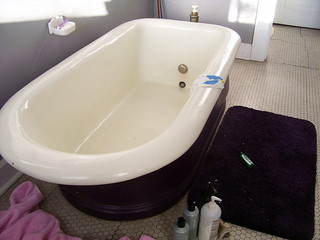
Refinishing a tub can be more affordable than buying a new one. But toxic chemicals can make the job fatal. Photo credit: Jeff Hart on Flickr. (Note: the tub in this photo is not related to the incidents described in this post.)
A new Hazard Alert from NIOSH, Dangers of Bathtub Refinishing was published in Feb 2013.
Since 2000, 14 workers in the US have died while doing this job. When I saw the new alert, posted on Twitter, it reminded me of a tragic story I heard last summer.
A 52-year-old worker died in a small, poorly ventilated bathroom of an apartment while using methylene chloride as a stripping agent. He was found “slumped over the tub on his knees with his face in the tub,” according to NIOSH.
All the deaths “involved the use of paint-stripping products containing methylene chloride, a highly volatile, colorless and toxic chemical that is widely used as a degreaser and paint stripper,” reads the article in Medical News Today. An in-depth report on the incidents is available from NIOSH’s Fatality Assessment and Control.
Exposure to extremely high levels of methylene chloride can be fatal. You could survive if you got away from this source that can result in what is described as “effects on the central nervous system (CNS) including decreased visual, auditory, and psychomotor functions” by the US Environmental Protection Agency.
While this type of tragedy is relatively rare, there are many chemicals to be wary of. Please review these resources, and be cautious with what you work with.
WHMIS: The Basics and WHMIS at Work from WorkSafeBC.
WHMIS: An Overview – a new WorkSafeBC ebook for iPad.
Also see Pages 8 to 11 of the Paint safety primer from ACTSafe.
And these:
Lead-Containing Paints and Coatings: Preventing Exposure in the Construction Industry


